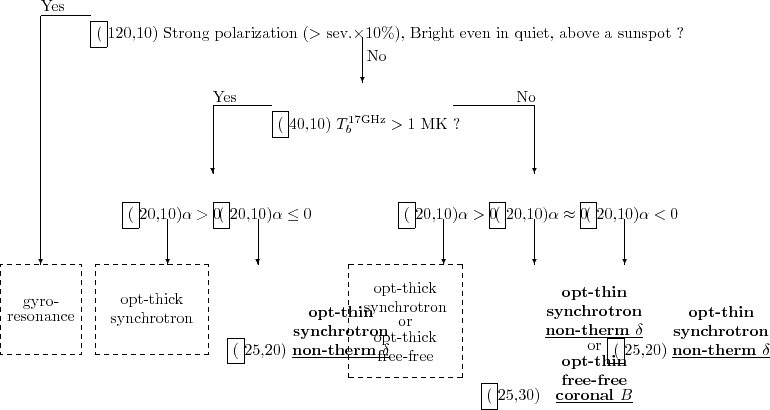 |
The interpretation is done by using the chart in Figure 5. Physical information can be obtained when the emission is by "optically-thin gyrosynchrotron" or by "optically-thin free-free". We can derive the variable using the Dulk's (1985) models.
In case "optically-thin gyrosynchrotron" emission,
we obtain power-law index of the non-thermal electrons.
Here we assume the distribution function of electrons to be
In case "optically-thin free-free" emission,
we obtain line-of-sight component of coronal magnetic field.
From the circular polarization degree ![]() ,
,
For example, figure 4 can be interpreted as follows:
First, the strong polarized source at
![]() is by
gyroresonance. It may be confirmed by comparing the image with
optical magnetogram to see if there is a sunspot. Next,
the area inside the contour line of
is by
gyroresonance. It may be confirmed by comparing the image with
optical magnetogram to see if there is a sunspot. Next,
the area inside the contour line of
![]() is emitting by optically-thin gyrosynchrotron. Non-thermal power-law
index
is emitting by optically-thin gyrosynchrotron. Non-thermal power-law
index ![]() is obtained from
is obtained from ![]() immediately and we see
that the emission from two-sides
of the loop structure is 'softer' than that of the top.
Next is for the area where
immediately and we see
that the emission from two-sides
of the loop structure is 'softer' than that of the top.
Next is for the area where
![]() .
Around
.
Around
![]() , it is hard to judge if it is
'optically-thin gyrosynchrotron' or
"optically-thin free-free" because
, it is hard to judge if it is
'optically-thin gyrosynchrotron' or
"optically-thin free-free" because
![]() .
If it is bright in soft X-ray it may be free-free emission.
In this case, line-of-sight component of coronal magnetic field
is obtained. Since the other area has
.
If it is bright in soft X-ray it may be free-free emission.
In this case, line-of-sight component of coronal magnetic field
is obtained. Since the other area has ![]() , it is
optically thick and no information can be obtained.
, it is
optically thick and no information can be obtained.